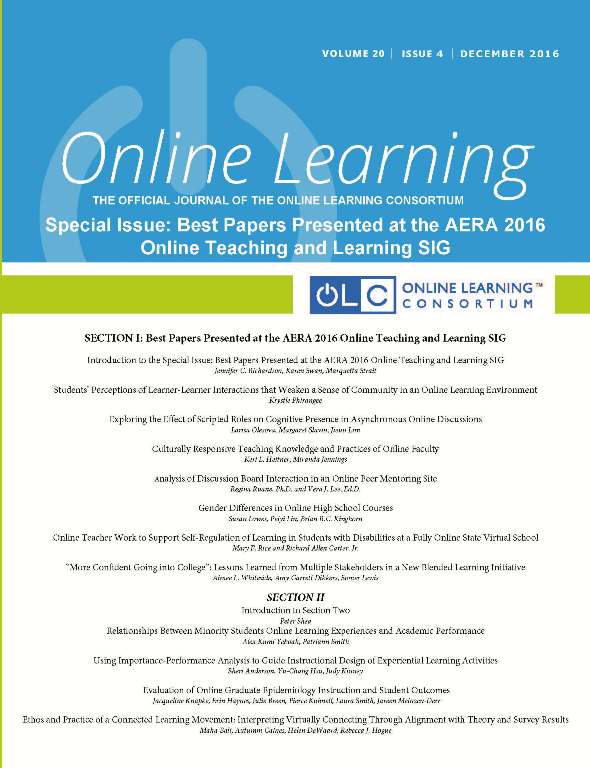Online Teacher Work to Support Self-Regulation of Learning in Students with Disabilities at a Fully Online State Virtual School
DOI:
https://doi.org/10.24059/olj.v20i4.1054Keywords:
Self-regulation, practicing online teachers, students with disabilities, teacher thinking about strategies, K12 virtual schools, online learning policyAbstract
Students with disabilities represent a growing number of learners receiving education in K-12 fully online learning programs. They are, unfortunately, also a large segment of the online learning population who are not experiencing success in these environments. In response, scholars have recommended increasing instruction in self-regulation skills for these students, but whether teachers are able to promote self-regulation as part of their instruction and how they will do so remains unknown. The purpose of this qualitative study was to examine how practicing teachers provided self-regulation strategies to students with disabilities in a fully online learning environment. In this context, the teachers intended to offer self-regulation strategies to students, but they were largely unable to do so. This work has the potential to influence professional development programs for online teachers in the hopes that students with disabilities will be able to learn self-regulation strategies and ultimately be more successful.References
Barbour, M. K., & Mulcahy, D. (2004). The role of mediating teachers in Newfoundland's new model of distance education.
Butler, D. L. & Winne, P.H. (1995). Feedback and self-regulated learning: A theoretical synthesis. Review of Educational Research, 65(3), 245-281.
Bernier, A., Carlson, S. M., & Whipple, N. (2010). From external regulation to selfâ€regulation: Early parenting precursors of young children’s executive functioning. Child development, 81(1), 326-339.
Boekaerts, M. & Corno, L. (2005) Self-regulation in the classroom: A perspective on assessment and intervention. Applied Psychology: An International Review, 54(2), 199-231.
Cavanaugh, C. (2007). Student achievement in elementary and high school. Handbook of distance education, 2, 157-168.
Clandinin, D. J., Murphy, M. S., Huber, J., & Orr, A. M. (2009). Negotiating narrative inquiries: Living in a tension-filled midst. The Journal of Educational Research, 103(2), 81-90.
de la Varre, C., Irvin, M. J., Jordan, A. W., Hannum, W. H., & Farmer, T. W. (2014). Reasons for student dropout in an online course in a rural K–12 setting. Distance Education, 35(3), 324-344.
Fernandez, H., Ferdig, R. E., Thompson, L. A., Schottke, K., & Black, E. W. (2016). Students with Special Health Care Needs in K-12 Virtual Schools. Journal of Educational Technology & Society, 19(1), 67-75.
Friedhoff, J. R. (2015). Michigan’s K–12 virtual learning effectiveness report 2013–2014.
Fritschmann, N. S., Deshler, D. D., & Schumaker, J. B. (2007). The effects of instruction in an inference strategy on the reading comprehension skills of adolescents with disabilities. Learning Disability Quarterly, 30(4), 245-262.
Gemin, B., Pape, L., Vashaw, L., & Watson, J. (2015). Keeping pace with K–12 digital learning: An annual review of policy and practice.
Graham, S., & Harris, K. R. (1993). Self-regulated strategy development: Helping students with learning problems develop as writers. The Elementary School Journal, 169-181.
Harris, K. R., Graham, S., & Mason, L. H. (2006). Improving the writing, knowledge, and motivation of struggling young writers: Effects of self-regulated strategy development with and without peer support. American educational research journal, 43(2), 295-340.
Marshall, C., & Rossman, G. B. (2014). Designing qualitative research. Thousand Oaks, CA: Sage publications.
Pintrich, P. R. (2004). A conceptual framework for assessing motivation and self-regulated learning in college students. Educational psychology review, 16(4), 385-407.
Sawyer, R. J., Graham, S., & Harris, K. R. (1992). Direct teaching, strategy instruction, and strategy instruction with explicit self-regulation: Effects on the composition skills and self-efficacy of students with learning disabilities. Journal of Educational Psychology, 84(3), 340-352.
Schunk, D. H., & Zimmerman, B. J. (2007). Influencing children's self-efficacy and self-regulation of reading and writing through modeling. Reading & Writing Quarterly, 23(1), 7-25.
Schunk, D. H. (2005). Self-regulated learning: The educational legacy of Paul R. Pintrich. Educational Psychologist, 40(2), 85-94.
Watson, J., Pape, L., Murin, A., Gemin, B., & Vashaw, L. (2014). Keeping pace with K-12 digital learning: An annual review of policy and practice. Evergreen Education Group.
Watson, J., & Kalmon, S. (2005). Keeping pace with K–12 online learning: A review of state-level policy and practice. Naperville, IL: Learning Point Associates.
Wehmeyer, M. L., Smith, S. J., Palmer, S. B., & Davies, D. K. (2004). Technology use by students with intellectual disabilities: An overview. Journal of Special Education Technology, 19(4), 7-21.
Weinstein, C. E., Mayer, R. E., (1986). The teaching of learning strategies. In Wittrock, M. C. (Ed.) Handbook of research on teaching, 3rd ed. (pp. 315-327). New York, NY: Macmillan.
Zimmerman, B. J. (2008). Investigating self-regulation and motivation: Historical background, methodological developments, and future prospects. American Educational Research Journal, 45(1), 166-183.
Downloads
Published
Issue
Section
License
As a condition of publication, the author agrees to apply the Creative Commons – Attribution International 4.0 (CC-BY) License to OLJ articles. See: https://creativecommons.org/licenses/by/4.0/.
This licence allows anyone to reproduce OLJ articles at no cost and without further permission as long as they attribute the author and the journal. This permission includes printing, sharing and other forms of distribution.
Author(s) hold copyright in their work, and retain publishing rights without restrictions






